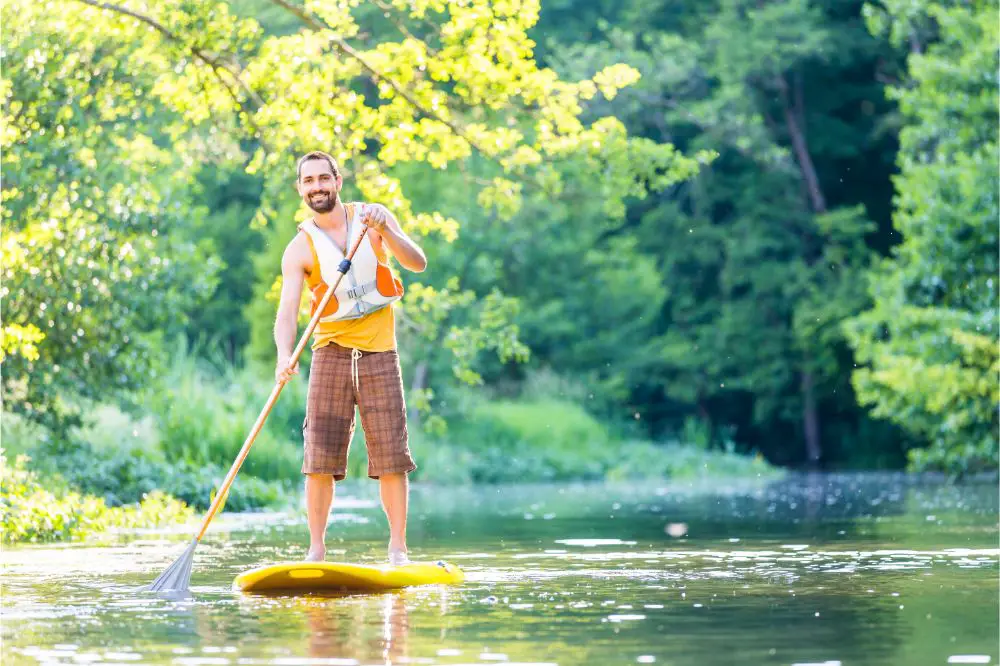It is standard and definitely highly recommended to have a personal flotation device (PFD) at your disposal whenever you want to go out on the water. These devices are designed to help you when you run into some trouble while out on the water on your paddleboard.
In this article we show you the different types of PFDs and explain which types are best for SUP. Finally, we will look at some of the best options available that may save your life while out paddleboarding.

Buyer’s Guide And Frequently Asked Questions
Finding the right product for your activities where you want to go out is not easy with so many to choose from. We will provide you with the right information to make it a bit easier to know what to look for in a PFD.
What PFD Is Best For SUP
The best personal flotation devices to use when you go out on your paddleboard are type 2 (has automatic turning to turn your face up if you are unconscious), type 3 (Have all the safety features to keep you afloat but without automatic turning), and type 5 (these are the specialised types of PFD with various specifications and safety features). But that is not the final answer because each type has its strengths and uses.
- It must have good buoyancy to keep you afloat until help arrives
- A PFD for SUP must be comfortable and provide enough freedom of movement
- For the experienced paddleboarders the type 5 is a good option because it comes with a waist belt included
- If you are planning a long trek with your paddle board you should consider having a type 5 PFD with you. For a normal day of fishing trip a type 2 or 3 will be efficient depending on your level of expertise.
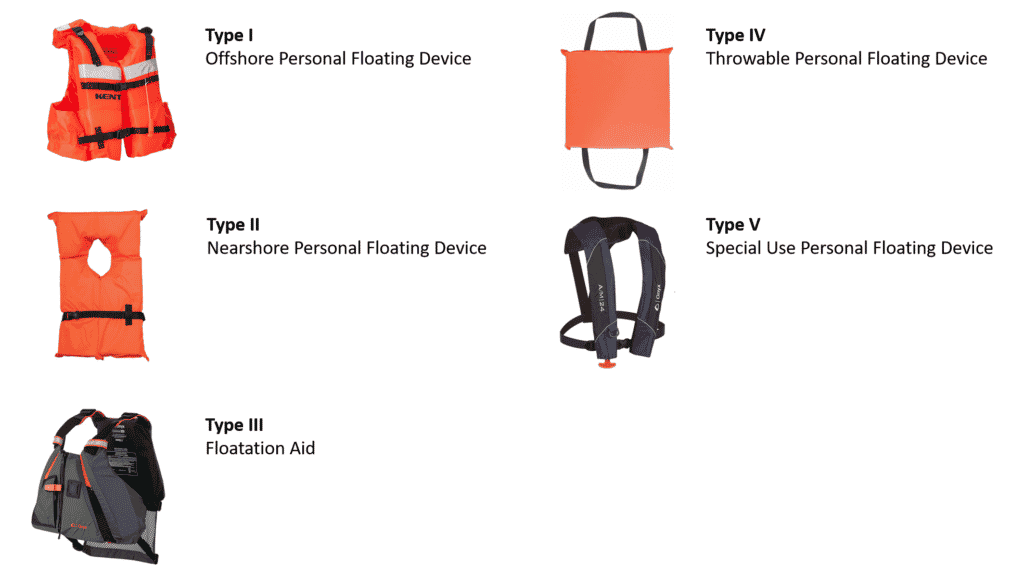
Type 2

This type of PFDs is made for calm conditions and inland waters closer to the shore. They are best to be used where there is a chance you can be rescued quickly and where there are many people around.
A type PFD is somewhat restrictive which means you will not be able to swim even for a short distance. Which makes this the best option for those who can not swim far or have a lot of paddle boarding experience.
If you intend to do surfing or yoga or planning a long trip or SUP camping,this type should not be considered. You can still use them for recreational paddleboarding or fishing trips.
Type 3

These flotation aids are easy to move around in and are quite comfortable to wear. As a paddleboarder, you need to have your arms free to use, making this type ideal.
This is also best for use where there is a chance of a quick rescue in calm waters and closer to the shore. For your safety, they are designed to put you face up when you fall in the water, but you need to turn your head.
The type 3 PFDs are mostly suited for leisure paddleboarding and fishing trips or for those who have little to no experience. We recommend that the type 3 PFD is used for the mentioned activities rather than a type 2 PFD.
Type 5
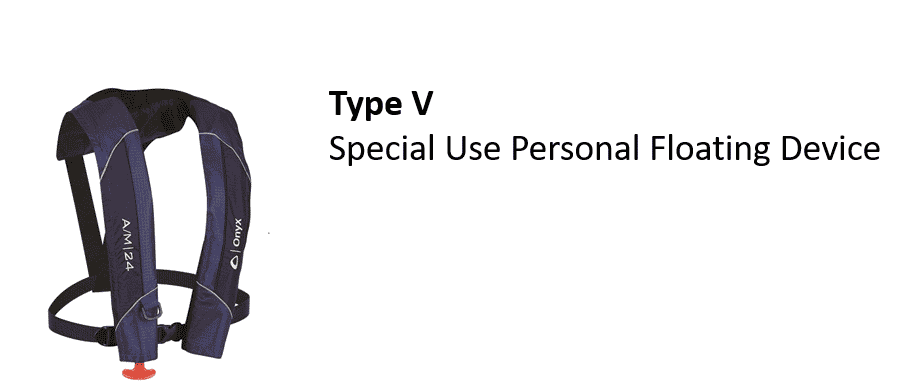
This is a special type of PFD that needs to be labeled for its use before being certified by the US coast guard. These devices are sometimes called hybrid PFDs and can be inflated or deflated when needed.
Inflatable belts are some of the PFDs that fall in this category, but they can also act as a type 3 device. They are the best option for experienced paddle boarders who want to go on long trips or SUP camping.
If you want to use your paddle board for yoga, surfing or any other activity where you need freedom of movement this is ideal.
Best SUP PFDs For Children
There are up to three categories of PFDs that are considered to be used for children to keep them safe in the water. These categories are based on the size and weight of the kids, and they are the following:
- 8 to 30 pounds for infants
- 30 to 50 pounds for children
- 50 to 90 pounds for youth
All PFDs for children must have a minimum buoyancy of 11 pounds, and any heavier than 90 pounds falls in the adult category. For infants, the type 2 PFD is ideal because it has some ability to turn the weare face up.
A type 1 PFD is the safest option for infants because of the automatic turning capability even in rough conditions. PFDs for children and youth are of type 3 style but only if they are used close to the shore and in calm waters.
Different Types Of PFDs
There are up to five different personal flotation devices, and they all have their specifications and uses. Following is a list of all the different types of PFDs and their specifications, and also the new level equivalents.
You will also see why some of them are great for paddleboarding and why others are not suitable.
Type 1 – Offshore PFD
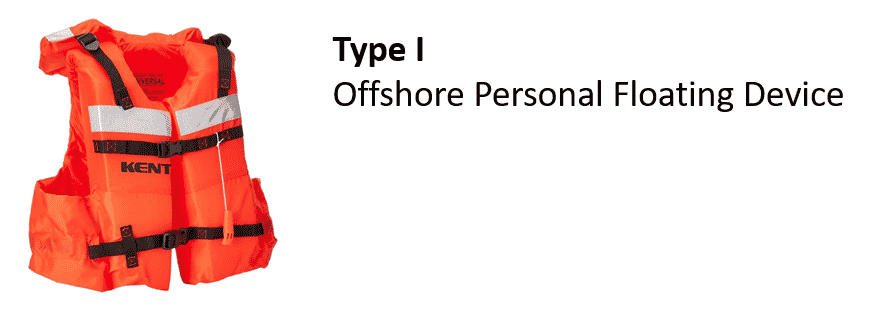
This type of PFD is suitable for all types of water and the many different conditions you may encounter. These are designed to put the faller with their face turned up in the water to keep you safe while waiting for rescue.
This PFD also comes with a buoyancy of 22 pounds for adults and a minimum of 11 pounds for children. They are also large and bulky and very difficult to move around in, so they are not great for boarding.
While most adults need only about 7 to 12 pounds of added buoyancy to lift their heads high enough out of the water, the buoyancy of these type 1 PFDs is sufficient to keep your head above water all the time.
For those who are using their paddleboards for long trips and other activities, these are the best option for their safety.
Type 2 – Near Shore PFD

Where there is a good chance you can be rescued quickly, these types of PFDs are the right choice. That is also why they are designed to be used in calm waters and closer to the shore.
They are slightly less bulky than the type 1 PFD and have a buoyancy of around 15 pounds minimum for adults. As is the case of all child PFDs this one also has a buoyancy of 11 pounds minimum for children.
It also has the disadvantage that it will not turn the face of the unconscious wearer up to keep their mouths above the water.
Even though type 2 does not have all the features of a type 1 they are still better for paddleboarders. That is because a type 2 provides you with more freedom of movement while with a type 1 you are quite restricted.
Type 3 – Floatation Aid

A type 3 PFD is also used in calm and near-shore waters where you do not need to wait too long to be rescued. They are specially made for different types of water sports such as fishing, boarding, and skiing.
The different devices that fall in this category are float coats, fishing vests, and water sports vests. They also come with a buoyancy of 15 pounds for adults and a minimum of 11 pounds for children.
It will also not turn an unconscious wearer face up when they fall into the water, so it is best used near other people. A type 3 is basically a bouncy aid for paddle boarders because they are not as bulky as a type 1 and type 2 PFD.
This means you can swim freely with them and paddle without restriction for long distances and are preferred by most paddlers.
Type 4 – Throwable PFD
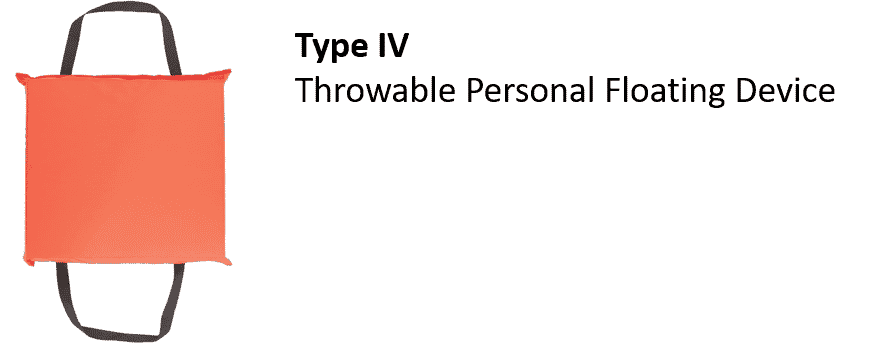
These PFDs are used to throw at a person who has fallen overboard to have something to hold on to while they wait to be rescued. These include such devices as ring buoys, horseshoe buoys, or floating cushions to give the person temporary buoyancy.
This type of PFD is intended only for backup support and is not intended to be worn as a PFD. They are also only to be used in calm waters where there is a quick chance of getting rescued.
Because this type of PFD is just a temporary solution they are not really suitable to be used by paddleboarders.
Type 5 – Special Use PFD

Type 5 PFDs are designed to be used in special locations and for specific activities.
This may include PFDs that can be used in very cold water that provides the wearer hypothermia protection.
Before using any of these special-use PFDs, you should ensure that they are labeled to be used in certain conditions. Deck suits, work vests, and boardsailing vests are some of the examples of devices that fall in this category of PFDs.
This special use Hybrid lifejacket has a low profile and can be inflated when you need to inflate it. It can also be deflated when it is not needed for their buoyancy while it provides freedom of movement for paddling and swimming.
The fact that they have all the safety features of the other types of PFDs, this one is the most favorable to use.
The New USCG Approval System For PFDs
The new approval system categorizes PFDs on their performance and what they are not approved for. See the following breakdown.
Level 50 Buoyancy Aid
This level of PFD is not to be used by those who can not swim and have no self-turning capability.
Level 70 Buoyancy Aid
This level is the same as the old type 3 PFDs and has no self-turning capability to keep your head above water. They are the most commonly used devices for recreational purposes and in calm waters only.
Level 100 Life Jacket
These are PFDs with high minimum buoyancy and have some self-turning capability, and can only be used near the shore. This is the same as type 2 personal flotation devices with the same type of buoyancy and self-turning.
Level 150
These devices can be used offshore, in rough water, and under other conditions with the highest buoyancy and reliable self-turning capability. They are the same as the old type 1 PFDs with the same safety specifications to keep you safe while waiting for rescue.
| PFD Type | Best For | Disadvantage | Buoyancy | Suitable For SUP | New level |
| Type 1 | Offshore and rough waters and all types of conditions | Bulky and heavy- not easy to move around in | Adults: 22 poundsKids: 11 Pounds | Yes | Level 150 |
| Type 2 | Calm waters and nearshore – safe for paddleboarding | It may not turn unconscious users to face up | Adults: 15 PoundsKids: 11 pounds | Yes | Level 100 |
| Type 3 | Calm and inland waters where there is a chance of a quick rescue | If you fall in the water, you must turn your head to the right position | Adults: 15 PoundsKids: 11 pounds | Yes | Level 70 |
| Type 4 | Only use in water where help is present | This is not designed or intended to be worn | Only use for temporary backup | No | Level 50 |
| Type 5 | It is intended for special use. Read the label for specifications. | Some of these are only approved when worn, and others are meant for cold weather only | Yes | Level 100/ Level 150 |
Best Personal Flotation Devices for Paddleboarding
See the following products for the type of use they are designed for and why they are the best for Paddleboarding.
PFD For Adult Paddleboarders
Type 3 Life Jacket
The Stohlquist Fit Unisex Adult Life Jacket
Even though this life vest is only available in adult sizes, it is still a nice design for a quick and easy fit. A non-restrictive cut makes it great for improved mobility while out on the water.
Type 5 Specialized PFD
This jacket can automatically inflate or be inflated manually to make it a safe device for boarding and other water sports. It is also equipped with pockets to hold CO2 cylinders and waterproof gear such as cameras.
PFD For Kids
Infants – Type 2 Nearshore Life Jacket
The New oceans 7 type 2 Life Jacket
With this device, you have sizes for all levels of children, from infants and up to youth, so there is a size for every child. The open-sided design with adjustable straps makes it a quick and easy-fit life jacket.
They are also available in a nice blue colour for boys and a pink for the little lady.
Children – Type 3 Life Jacket
Onyx MoveVent Dynamic Paddle Sports CGA Life Vest
A whistle is attached to this strong and durable life vest to improve the safety factor for the wearer. Thes vests are available in all sizes, and all categories for children.
Youth – Type 3 Life Jacket
The Stohlquist Youth Life Jacket
This high mobility life jacket for youth comes with a 12 to 14 pounds buoyancy factor to make it safe for this group of people. With up to 8 selections of adjustability this will suit almost every size and shape of person.
Soft low-profile foam provides maximum comfort while the vest will keep you afloat.
Summary
As said at the beginning: we stronly suggest that you always use a PFD while Paddleboarding. Ideally, you choose a PFD which gives you the maximum degree of freedom while having enough buoyancy for your weight. The more experience you have with watersports, the more you should opt for an inflatble Type V PFD as those do not hinder your paddle movements not at all.
We hope that we were able to help you to make a good decision – and we have much more information about Stand Up Paddling for you!
Check it out!

